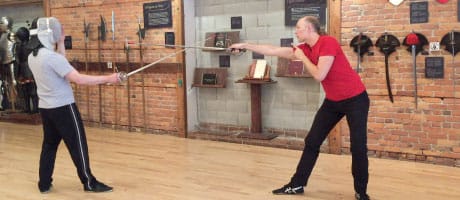The Deceptive Fight is a strategy based on the opponent’s knowledge and reliable execution of The True Fight (Mechanics, Strategy), whereby the fencers seek to control measure, tempo and the opponent’s blade.
Invitations: We present attacking lines to the opponent that appear open and available to them. However, our defenses and counter attacks are ready to go, and we deliver them in a time when the opponent is least able to deal with them.
Feints with Cover: Our covered attack should draw the predictable response from the opponent: defense. We use false attacks to draw our partner’s sword into defensive motions, and use those tempos to renew our true striking intention.
Measure and Voids: We can use distance as our ally to make feints safer. When at closer measures, we can also use angle to move our bodies offline (laterally or vertically) in order to remain safe from the opponent’s blade.
Feints in Tempo: Making feints in an opportune moment means making them while the opponent is least able to attack us. For instance, they may be stepping forward, or they may be recovering their blade position. These lessons delve into both short and long sequences of bladeplay that highlight the best of tempos in which to deliver a feint.
Acknowledgement of Safety and Risk
- Practice all exercises slowly and with control.
- Practice using training swords that are not sharp and are specifically made for practice.
- Use protective gear for all exercises. In many of our videos we are not wearing head, throat or body protection in order to make clear explanation more possible. You should always use protective gear when practicing these arts regardless of the exercise.
- Be aware that injuries in training are always possible. Ensure that you are practicing with care and caution at all times.
- DuelloTV is not responsible for any injuries that occur as a result of sword practice inspired from our videos.
